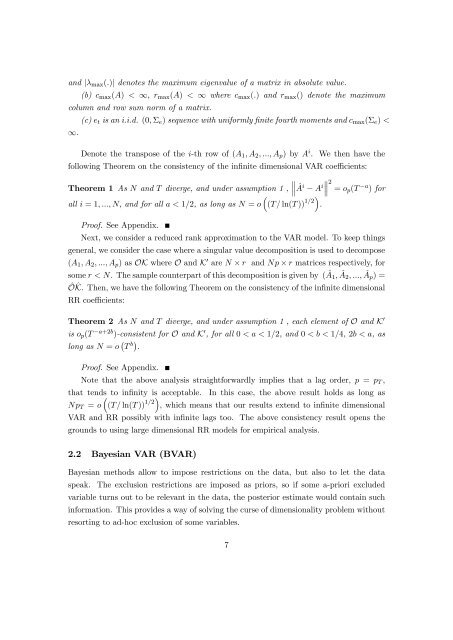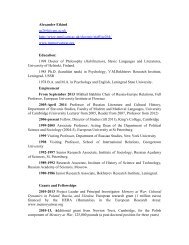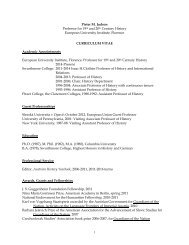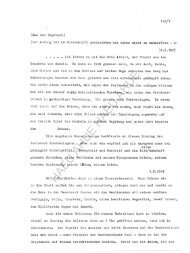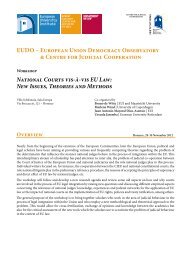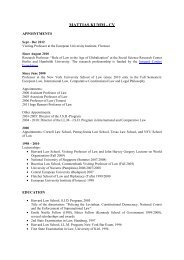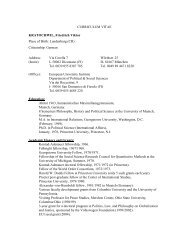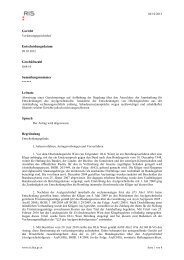Forecasting Large Datasets with Reduced Rank Multivariate Models
Forecasting Large Datasets with Reduced Rank Multivariate Models
Forecasting Large Datasets with Reduced Rank Multivariate Models
Create successful ePaper yourself
Turn your PDF publications into a flip-book with our unique Google optimized e-Paper software.
and j max(:)j denotes the maximum eigenvalue of a matrix in absolute value.<br />
(b) cmax(A) < 1; rmax(A) < 1 where cmax(:) and rmax() denote the maximum<br />
column and row sum norm of a matrix.<br />
1.<br />
(c) et is an i.i.d. (0; e) sequence <strong>with</strong> uniformly …nite fourth moments and cmax( e) <<br />
Denote the transpose of the i-th row of (A1; A2; :::; Ap) by A i . We then have the<br />
following Theorem on the consistency of the in…nite dimensional VAR coe¢ cients:<br />
Theorem 1 As N and T diverge, and under assumption 1 , A^ i Ai 2<br />
= op(T a ) for<br />
all i = 1; :::; N; and for all a < 1=2, as long as N = o (T= ln(T )) 1=2 .<br />
Proof. See Appendix.<br />
Next, we consider a reduced rank approximation to the VAR model. To keep things<br />
general, we consider the case where a singular value decomposition is used to decompose<br />
(A1; A2; :::; Ap) as OK where O and K 0 are N r and Np r matrices respectively, for<br />
some r < N. The sample counterpart of this decomposition is given by ( ^ A1; ^ A2; :::; ^ Ap) =<br />
^O ^ K. Then, we have the following Theorem on the consistency of the in…nite dimensional<br />
RR coe¢ cients:<br />
Theorem 2 As N and T diverge, and under assumption 1 , each element of O and K 0<br />
is op(T a+2b )-consistent for O and K 0 , for all 0 < a < 1=2, and 0 < b < 1=4, 2b < a, as<br />
long as N = o T b .<br />
Proof. See Appendix.<br />
Note that the above analysis straightforwardly implies that a lag order, p = pT ,<br />
that tends to in…nity is acceptable. In this case, the above result holds as long as<br />
NpT = o (T= ln(T )) 1=2 , which means that our results extend to in…nite dimensional<br />
VAR and RR possibly <strong>with</strong> in…nite lags too. The above consistency result opens the<br />
grounds to using large dimensional RR models for empirical analysis.<br />
2.2 Bayesian VAR (BVAR)<br />
Bayesian methods allow to impose restrictions on the data, but also to let the data<br />
speak. The exclusion restrictions are imposed as priors, so if some a-priori excluded<br />
variable turns out to be relevant in the data, the posterior estimate would contain such<br />
information. This provides a way of solving the curse of dimensionality problem <strong>with</strong>out<br />
resorting to ad-hoc exclusion of some variables.<br />
7


